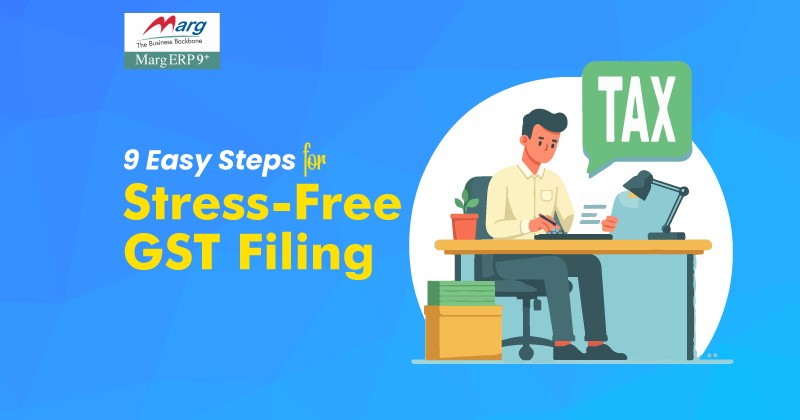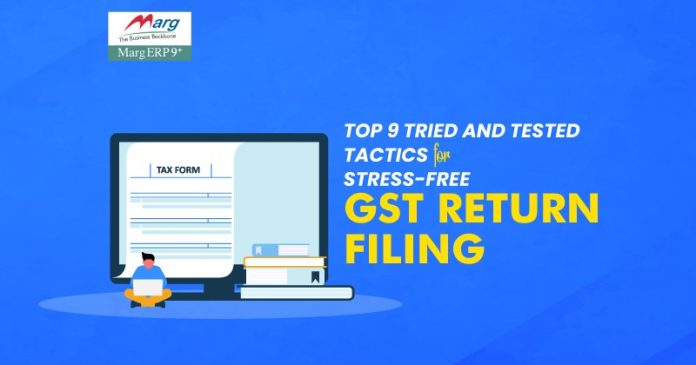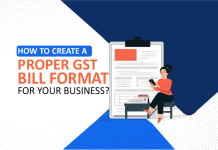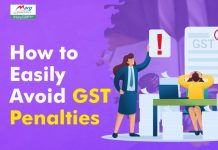One of India’s greatest tax reforms implemented on the 1st of July, 2017, the Goods and Service Tax, is a comprehensive tax levied on the supply of goods and services. The GST model in India entails the enactment of two components of taxation, Central Goods and service tax and State goods & service tax. It worked to replace all the indirect taxes such as central excise duty, single VAT, central state tax, and purchase tax. The implementation of GST has turned out to be of great benefit to business owners in India.
Different types of Goods and Service Taxes
The goods and service tax have been classified into 3 broad categories, namely, CGST, SGST, and IGST.
- CGST or Central Goods and Service Tax is the tax that is levied by the central government on the intra-state supply of goods and services within one single state in the country.
- SGST or State Goods and Services Tax is levied by the state government on the intra-state supply of goods and services within one single state in the country.
- IGST Integrated goods and service tax is levied by the central government on the interstate supply of goods and services between two different states in India.
The CGST and the SGST are collected by the governing body of the state where the supply takes place and the IGST is distributed to the destination state after the central government collects it.
What Is a GST Return? Who Should File, Due Date, and Types?
GST-registered businesses are mandated to file monthly, quarterly, and annual returns of their business, based on the government-regulated slabs as per their businesses. A GST return is a document compilation of all tax-related credentials like details of income sales expenses purchases etc. That is used by tax authorities to calculate the net tax liability. The details in the GSTR document include:-
Details of sales and purchase.
Output GST on Sales
Input tax credit or GST paid on sales.
Under the goods and service tax regime, 13 types of return in GST document a taxpayer’s financial transactions and tax liabilities. They are,
GSTR-1
GSTR-1 is filed against all the goods and services provided by a company. Every registered firm is mandated to file this form. It is to be paid monthly by the 11th of every month. For firms registered under the QRMP scheme, it is to be paid quarterly by the 13th of the following quarter.
GSTR-3B
This is a form of monthly self-declaration. It shows a comprehensive detail of All outward supplies made Input tax credit claimed tax liability taxes paid. GSTR-3 is to be paid monthly by the 20th of every month and for businesses registered under the QRMP scheme, it is to be paid quarterly, by the 22nd or 24th of the month of the following quarter.
GSTR-4
GSTR-4 is an annual return form that is required to be filled by taxpayers who are registered under the composition scheme, that is. It demands to be filled annually by 30th April following the relevant financial year. It can be replaced by GSTR-9A. It is paid annually by the 30th of the month following a financial year.
GSTR-5
GSTR-5 is to be filed by the registered non-resident Indians, during the period they are carrying out their businesses in India. They contain the details of outward supplies made inward supplies received credit-debit notes tax liability taxes paid.
GSTR-5A
GSTR-5A entails the tax payable by OIDAR, which stands for, Online Information and Database Access or Retrieval Services Provider. Both GSTR-5 and GSTR-5A are to be paid monthly by the 20th of every month.
GSTR-6
GSTR-6 is to be filed by the Input Service Distributor (ISD). It is payable monthly. It comprises the input tax credit distributed by ISD and all the details of all the documents related to the input tax credit. It is paid monthly by the 13th of every month.
GSTR-7
This return is filed by the people who are required to deduct Tax deducted at source (TDS) under GST. It comprises the details of TDS deducted, TDS liability payable and paid, and TDS refund if applicable. It is paid monthly by the 10th of next month.
GSTR-8
This form is required to be filled by the e-commerce operators who are registered under the GST regime. Tax collected at source (TCS) is a statement of. It is paid monthly by the 10th of next month.
GSTR-9
GSTR 9 contains details of outward supplies made, Details of outward supplies made, inward supplies received, a summary of supplies received under the HSN code, and details of tax payable and paid. It is paid annually on the 31st of December of the next financial year.
GSTR10
The final return or GSTR 10 is to be filled by those whose registration has been cancelled due to some reason. It is required to be filled within three months of the cancellation order and the date of cancellation, depending upon what comes first.
GSTR-11
Foreign embassies and diplomatic missions who do not pay taxes in India but require a refund of taxes are to fill the form, in order to receive a refund of the goods & service taxes incurred by them in India. It is to be filed by only those who have been issued a Unique Identity Number (UIN). The forms include the details of the inward supplies received and the refund claimed. This is paid on the 28th of every month, after the month in which the statement is filed.
CMP-08
It is a statement-cum-challan, the taxpayers who are registered under the composition taxable person are required to fill this form in order declare the details of their self-assessed tax payable for a given quarter. CMP-08 is paid quarterly by the 18th of the month following the quarter.
ITC-04
Abbreviated for Input tax credit, it needs to be filled by a registered manufacturer to report the details of goods sent to, and received back from the job worker. Or sold off from the job worker’s place. It is to be paid annually by 25th April for businesses with an Annual Aggregate Turnover of up to 5 crores, and for businesses with an annual aggregate turnover of more than 5 crores it is to be paid half yearly by 24th of October too.
A taxpayer has to file based on the type of return in GST registration obtained by their business.
9 Easy Steps for Stress-Free GST Return Filing

GST filing can be a tough job, for an individual to do all by himself, and getting an accountant to do the job can be an expensive thing for small .. enterprises and startups so here is a step-by-step detailed guide on how to fill GST returns hassle-free.
Now here is an easy 9-step guide on how to fill in your GSTR.
Step 1:-
The first and most important step to file your GST Return is to get your business registered. Getting your business registered gives you a GSTIN. GSTIN is abbreviated for Goods & Service Tax Identification Number. It is allocated to every taxpayer, especially business owners under the goods & service tax regime. Getting your business registered will help your firm get legal recognition and allow SMEs and startups to expand their potential by getting an opportunity to register on an e-commerce platform and create their own ecommerce website.
Step 2:-
After successful registration of your firm and receiving your GSTIN, visit the GST portal. www.gst.gov.in and login using your username and password and then click on the services tab.
Step 3:-
On the next page, click on the option called “Returns Dashboard” After that, a dropdown menu will appear wherein you are required to choose the financial year you are filling the GST return.
Step 4:-
From the next menu you need to choose the types of return in GST you need to file. From the next set of options where you are required to choose how to file the return, for the online GST return Process, click on the “Prepare Online” option.
Step 5:-
After that you are required to enter your correct credentials, in their respective fields, including the details of the pending late fees. Next, you save the form and then submit it. To ensure the status of your GST Return, make sure it has been changed to “Submitted”.
Step 6:-
After the status of your complaint has been changed to “Submitted”, click on “Payment of Tax”, and then on “Check Balance”. This will reveal your credit and cash balance.
Step 7:-
Click on “Offset Liability” to make the GST payment online in a few minutes. Check off the relevant boxes for declaration.
Step 8:-
After checking off all the boxes, click on “File form with DSC” or “File form with EVC”
Step 9:-
The last and final step to file the GST Return is to make the payment and you are done with the procedure in no time.
What Is GST Billing Software, and How Does It Help in Hassle-Free GST Filing?
GST billing software is a tool that helps in improving financial records and simplifying the invoicing procedure, consequently helping in keeping up with GST compliance. GST billing software facilitates financial management by generating GST invoices in compliance with the GST regulations and accurate calculation of GST on every purchase. It submits GST returns quickly and efficiently. One software that will facilitate your GST billing is Marg ERP. Marg ERP offers you the feature of bulk GSTIN verification and easy procurement of GST tax invoice which is a cost-effective, time-saving accurate, reliable and efficient solution.
Conclusion
In conclusion, GST billing is an important aspect of the Goods & Service Tax system in India. It involves generating invoices, maintaining records of sales and purchases, and calculating the applicable taxes. By implementing efficient GST billing practices, businesses can ensure compliance with tax regulations, and streamline their maintaining accurate financial records.
Frequently Asked Questions (FAQs)
Are GSTRs filed every month?
Businesses need to file one monthly GSTR,i,e., GSTR-1 and the rest GSTRs are to be filed based on the type of GSTR chosen to be filed by the businesses. They are Annual, Half Yearly, or Quarterly.
What is the QRMP scheme?
QRMP scheme or the Quarterly Return filing or Monthly Payment of Taxes scheme, has been introduced in the GST regime to file their Form GSTR-1 and Form GSTR-3B returns quarterly, while paying their tax dues every month through a challan.
Can I revise my GSTR after filing?
Yes, you can revise your GSTR after filing, if by any chance you discover any errors. However these revisions are only allowed within a specified time limit and are subject to conditions, therefore it is important to review your GSTR before filing.
What is the information required for filing GSTR?
While filing your GSTR, you need to provide details such as outward supplies sales, inward supplies or purchases, tax liability input tax credit, GST tax invoice, and any other relevant information as per the prescribed format.
What is the consequence of non-filing or late filing of GSTR?
Late or non-filing of GSTR can result in penalties and interest charges. It may also affect your compliance rating and ability to claim input tax credits. It is crucial to file GSTR on time to avoid any complications.




















